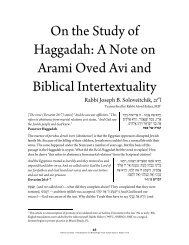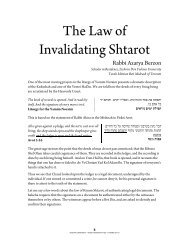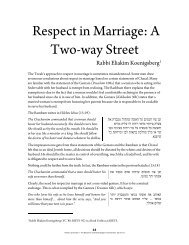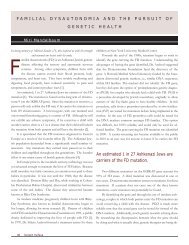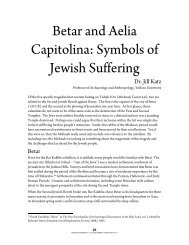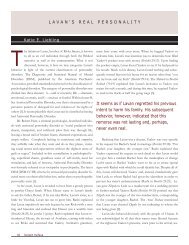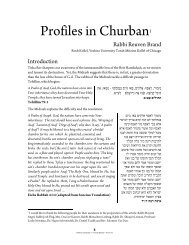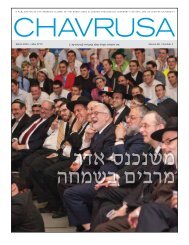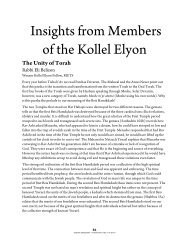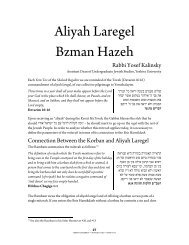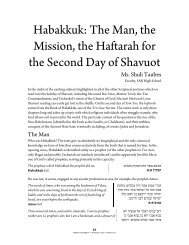YESHIVA UNIVERSITY • ROSH HASHANA TO-GO ... - YUTorah.org
YESHIVA UNIVERSITY • ROSH HASHANA TO-GO ... - YUTorah.org
YESHIVA UNIVERSITY • ROSH HASHANA TO-GO ... - YUTorah.org
Create successful ePaper yourself
Turn your PDF publications into a flip-book with our unique Google optimized e-Paper software.
can this mental commitment be enough to characterize this person as a righteous man – he cannot<br />
be viewed as having properly done teshuvah, because he made no confession.<br />
According to the aforementioned understanding of the Rambam, though, the answer is clear.<br />
Teshuvah, as explained, is a process, consisting of many steps. A mental commitment to mend<br />
one’s evil ways is one of those steps – possibly the very first step. The vidui, consisting of the<br />
three components outlined above, is another, later step. But even that brings one to only one<br />
level of teshuvah; the ultimate teshuvah, “complete” teshuvah, is further yet down the road. The<br />
individual who mentally committed to change his behavior for the better has certainly not done<br />
complete teshuvah. He has not even done teshuvah on the basic level, as he did not recite vidui.<br />
But he has taken a step; he is on the road. And concerning at least this particular law of betrothal,<br />
his being on the road is sufficient to qualify the person as righteous. 129<br />
It should be pointed out that this idea that teshuvah is in fact a process with a number of steps,<br />
and that a mental decision to do teshuvah is an early one of those steps, can be shown to emerge<br />
from the words of the Rambam himself. As alluded to above, the Rambam in א : א,<br />
when<br />
introducing the formula for the text of vidui, prefaces his presentation of the mitzvah of vidui<br />
with the words “הבושת השעישכ,” “when he does teshuvah.” This implies that the decision in the<br />
person’s mind to do teshuvah has already happened; the first step has been taken. The notion is<br />
even more clearly evident in the words of the Rambam in describing the procedure followed<br />
when bringing certain sacrifices:<br />
How does one confess? He says, “I have sinned, been iniquitous and<br />
willfully rebelled, and I have done such and such; but I have returned<br />
through teshuvah before You, and this [sacrifice] is my atonement.”<br />
Hilchot Maaseh HaKorbanot 3:15<br />
54<br />
<strong>YESHIVA</strong> <strong>UNIVERSITY</strong> <strong>•</strong> <strong>ROSH</strong> <strong>HASHANA</strong> <strong>TO</strong>-<strong>GO</strong> <strong>•</strong> TISHREI 5771<br />
יתיוע יתאטח רמוא הדותמ דציכ<br />
יתרזחו ךכו ךכ יתישעו יתעשפ<br />
יתרפכ וזו ךינפל הבושתב<br />
וט:<br />
ג תונברקה השעמ 'לה<br />
According to this, the individual, as an actual part of the text of his vidui, declares, “ יתרזחו<br />
הבושתב,” “and I have returned through teshuvah.” Note that this phrase is in the past tense; the<br />
person is thus stating when he recites his vidui that he has already done teshuvah, at least in<br />
some sense. Some form of teshuvah comes first, the formal, technical vidui comes a little later,<br />
and, if all goes well, “complete” teshuvah is attained later still.<br />
It seems clear from all of the above that at least according to the Rambam, there are many steps<br />
which must be taken as part of the overall teshuvah process, and each one is important in its own<br />
right. It is conceivable that one may never fully achieve the total personality change identified<br />
with complete teshuvah, and the attainment of these other levels of teshuvah is thus to be<br />
encouraged and is commendable as well, as each step brings the individual closer to Hashem. At<br />
the same time, however, the ultimate goal of teshuvah remains the transformation of one’s<br />
character, the metamorphosis into a person no longer even tempted by the sins which were<br />
previously violated, difficult though reaching that goal may be.<br />
129 HaRav Soloveitchik is cited in Harrerei Kedem (Volume 1 Chapter 35) as having presented a similar<br />
understanding of this sugya in Kiddushin. It must be noted here that both the Rambam (Hilchot Ishut 8:5) and the<br />
Shulchan Aruch (Even HaEzer 38:31) rule that the betrothal in this case is not definitely valid, but rather that it might<br />
be valid (קפסמ תשדוקמ). See Beit Shmuel #55 and Chelkat Mechokek #44 there; see also Ohr Zarua I:112.



